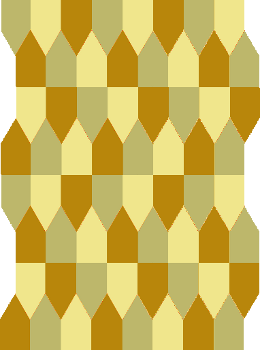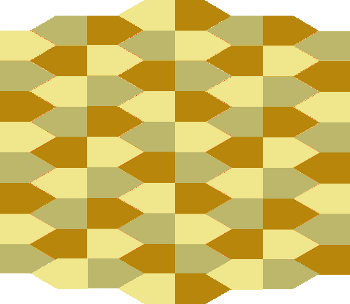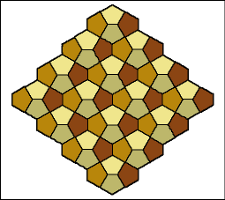Comments by graeme
Thanks for the input Jeremy. I've adopted your berolina pawns and leo - and also have increased the board size further - to produce these 2 related variants, described more fully here.
'... One question: are the routes a1-d1, b1-e1, and c1-f1 also barred?'
No, they are not barred. I've added an explicit statement to this effect under the description for the Bishop.
I agree the use of the twisted knight for the tusker is not ideal - but they do both begin with t. I'm not sure what to do - there is no other Icon in the set used that is any more appropriate and I do not know how to add a new Icon even if I could design one. I am open to suggestions as how best to proceed
Thank you for your comment and your rating. And thanks for mentioning the poor link design - a bad habit I am trying to break. I have removed the deprecated target=_blank property from the links to return browser control back to the user.
Your understanding about the connection of the poles with their adjacent cells is correct. It should be noted that from the starting position the Horses, although appearing under threat, cannot in fact be captured by the Cannons as this would place the General (King) in check.
Hi David,
Sure, though the file needs some tidying up before being published.
Should be ready in the next day or two.
Cheers,
Graeme
The zrf has been uploaded but the page is currently hidden
Thanks for the comments, Joe. I was thinking of adding a note on using random assignment of the final destination hex as a variant, but in the end decided that the Quantum concept was already radical enough in itself.
Play testing has been minimal. I used Zillions running a non-quantum version to test and refine the transfer of Ultima to a hex board, but have not yet been able to get a working Quantum version. I have just finished constructing a non-enforcing pre-set and would be happy to push a few pieces around at a leisurely pace.


Another board of pentagons that might be of interest is this:

And why the colours? I just think it looks nicer when presenting a board
with no game context.
Of course if the board were to be used in a variant, the number of colours
and their placing might need more careful consideration.
'I think your image of the contraction capture is off...also I'm not sure I understand the Drop rule. Can you get the queen before placing the remaining four pawns? Are captured pieces droppable?'
Sorry, but I'm unclear what point you're making about the contraction capture image. Can you elaborate please?
There are 4 drop levels, and each side begins the game on the first level. At this level only Pawns can be dropped. On dropping the fourth Pawn the level for that player advances to the second. On the second level Knights and Bishops can now be dropped as well as Pawns. The third level is reached when the second Knight or Bishop is dropped. Rooks may be dropped at the third level. Dropping a single Rook advances that players drop level to the fourth level. Once the fourth level is reached the Queen may be dropped.
Captured pieces are removed from the game. They cannot re-enter the game by being dropped again.
Yes I played chess before discovering chess variants. I played for my school team and at university, and when I got my first job for a London based insurance firm I played for them in the London Insurance Chess League. I also played in some local leagues and chess tournaments.
These activities came to a halt with the arrival of children and a career change from insurance to IT. Although I still play chess, my real passion is for wargaming (also started way back in my school days) and much of my gaming time is taken up with perfecting my own set of rules for my own particular circumstances.
Most of my CV designing is inspired by ideas from other activities - like my degree studies with the Open University - and tend to be very conservative in terms of pieces used.
Charles: I respect your right to your opinion, but please leave me out of your squabbles. If you have a comment to make on my variant or its presentation then kindly do so in the appropriate comment area.
Graeme.
Hi Nick,
I'd thought about the 3-step first move for a pawn, but decided to leave it at 2-steps as I was trying not to move too far from FIDE.
Cheers
Graeme
Hi Nick,
Zillions develops Knights and Archbishops first, eventually moving Pawns to attack encroaching enemy pieces. Hopefully my Zillions file will be posted here soon.
Cheers
Graeme
Yes, Charles, castling is only allowed with Rooks on the same rank. And the comparison with your variants is certainly interesting - particularly so with my newly added 10x10 subvariant.
Enthronement
The intention is that this is allowed only with respect to your own Regents.
Randomness
The use of cards or dice to determine the final landing square is certainly worth exploring.
'The single defining quality of 'Chess' is that the winning condition is predicated on one (the royal) of two (royal and non-royal) classes of pieces If a game exhibits this quality it is a Chess Variant, if it doesn't it isn't.' (http://chessvariants.wikidot.com/chess-variants)
Just a few thoughts about the Likes table:
- It might be useful to include an ID for the item's creator. I know this can be found by joining through the ItemID but keeping it in this table as well would enable faster queries concerning games inventors. It would also make it easier to stop creators rating their own games (UserID != CreatorID)
- Will a user be able to revise their ratings? If so the table will need a timestamp field and possibly either a binary current/superseded field or a status field. Or previous ratings might have their own table - LikesHistory
Relational Database terminology:
- Candidate Key - a column or set of columns providing data that is unique for each row. Where a set of columns is involved the term Composite Candidate Key is used.
- Primary Key - the Candidate Key that is the main index for a table and which will be used as a Foreign Key in other tables. For performance purposes a Primary Key will usually not be Composite.
- Foreign Key - the Primary Key of another table.
- Key - when used without qualification will normally be understood to be shorthand for Primary Key
Self-rating - personally I would be wary of such a practice, not because I think inventors are always going to give maximum marks to their own games, but because they are too close to their own games to provide a disinterested assessment.
Overwriting of data due to revision of values leading to loss of historical data strikes me as being what would be called 'bad practice'. But I guess I'm guilty of trying to apply corporate standards in a non-corporate situation.
Fergus Duniho writes:
What kind of performance issues are there? With a composite primary key, will it search individual keys until it finds a match instead of directly knowing where to go?
It is quicker to traverse a numeric key than an alpha or alpha-numeric. But it is not just a question of machine performance - development time including code production (manual and automated) and testing can be less efficient with composite primary keys. There is also the question of maintenance and the persistence of natural composite keys when compared to surrogate primary keys.
But this isn't the place to conduct a seminar in database design and I have already declared myself guilty of misapplying enterprise practice - it isn't easy, sometimes, to put aside work practices gleaned over 3 decades.
In game theory Hierarchical Games model conflict systems with a structure of control levels ranked in a certain order. Thus in a wargame there might be an overall commander, several sub-commanders, and many unit commanders, per side. Troop movements and performance would depend upon the placement and movement of these commanders.
They need not be team games. The command/control structure may be used to determine movement of non-command units/pieces. Have a look at Joe Joyce's Chieftain Chess for an example of an hierarchical game. Whether or not the term "wargame" is sufficient by itself is debatable. In the context of CVs it probably is.
 . Eurasian Chess meets Courier-Spiel.[All Comments] [Add Comment or Rating]
. Eurasian Chess meets Courier-Spiel.[All Comments] [Add Comment or Rating]I will allow that the description on the chessvariants wiki might be a little terse, but I think it at least adequate, with each non-compound piece having a movement diagram.
25 comments displayed
Permalink to the exact comments currently displayed.

I feel the board may be a tad small, and think increasing it to 6 hex on a side might be better. Also the problems with the rooks could be resolved by moving them to the back rank and turning them into crowned-rooks (dragon kings). To complement these and to complete the second row I've added a couple of crowned-knights (centaurs). Here's my suggestion.